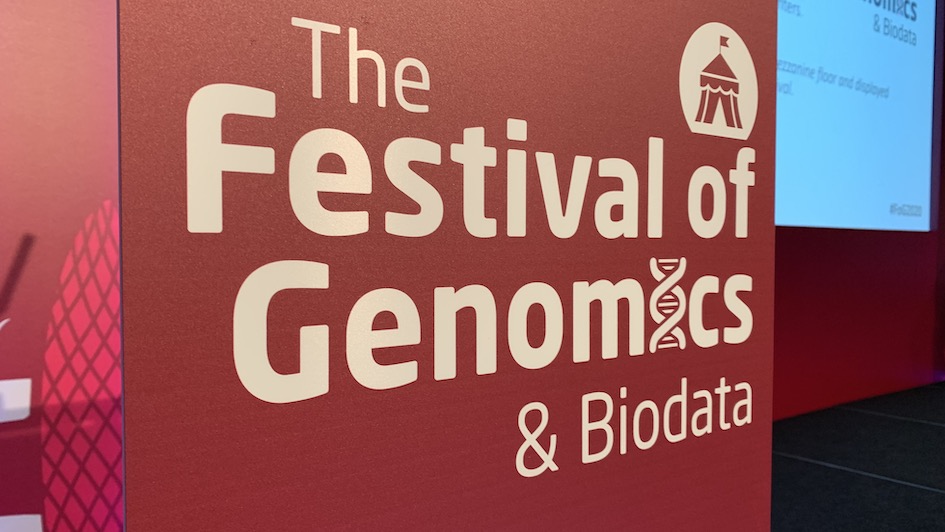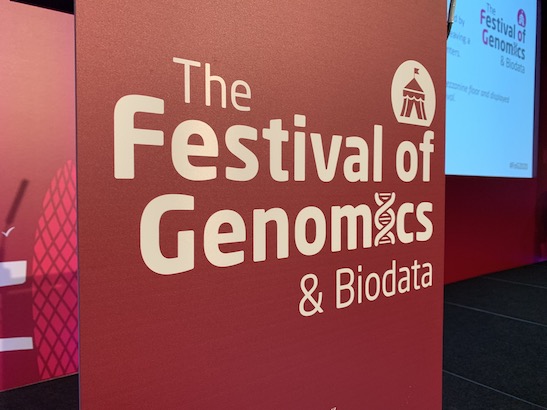
The Festival of Genomics and Biodata – the UK's largest genomics event, with more than 7,000 attendees – is a great place for the global genomics community to meet.
Researchers from The Institute of Cancer Research, London, were present, including Professor Paul Workman, Professor Clare Turnbull and Dr Anguraj Sadanandam, who gave talks at the conference that ran from 25-28 January 2022.
How genomics is improving healthcare
Professor Dame Sue Hill, Chief Scientific Officer for NHS England, delivered the introductory keynote and explained how NHS England plans to keep up the momentum in genomics.
As she described, the UK holds a world-leading position in genomics, having been heavily involved in the Human Genome Project in the early 2000s and committed to sequencing 100,000 whole human genomes from patients with rare diseases and common cancers back in 2012.
Fast-forward to today and the NHS has launched the NHS Genomic Medicine Service and a world-first whole genome sequencing service, hoping to become the first national health care system to offer whole genome sequencing as part of routine care.
Next, the NHS and Genomics England will focus on the ‘Cancer 2.0’ initiative – a proof of concept to explore the use of long-read sequencing (LRS) technology in cancer.
Our genome is too long to be sequenced in one go. Scientists often use short-read sequencing technology, where short fragments of DNA are sequenced separately and then pieced together. Long-read sequencing enables faster sequencing of longer fragments.
The hope is that the Cancer 2.0 project will introduce new technologies like this to support earlier, faster diagnosis – cutting waiting times from weeks to days in some cases.
Another priority for Genomics England is diversity in genomic data. In the next few years, they hope to enrich their genomic datasets, sequencing cohorts of diverse backgrounds.
A genomics approach to drug discovery
The ICR’s Professor Paul Workman, Harrap Professor of Pharmacology and Therapeutics, delivered another of the opening keynote speeches, focusing on 'drugging' the cancer genome.
“It has been 21 years since the human genome was first sequenced and released, and that has had an enormous impact of cancer drug discovery and development,” he said.
New understanding of cancer genomes helps researchers identify new targets for drug development, and even repurpose drugs that already exist. So, putting it simply, using our knowledge of genomics increases the probability of drug development success.
This is hugely important, since the cost of drug discovery and development is prohibitive – it costs around 2.6 billion dollars for a drug to come to the market and reach patients. This means that any help to pinpoint drug candidates as accurately as possible is desirable.
Despite all the investment in cancer research and discovering new cancer drugs, oncology has one of the lowest approval rates, at around 5 per cent – and it takes an average of 10.5 years for a cancer drug to go from phase I trials to regulatory approval. There are many reasons for this delay from ‘patent to patient’ – highlighted in our Drug access report, which shows it’s particularly hard for innovative drugs to get rapid approval.
But using genetics across the drug development pipeline – to validate targets and find biomarkers, for example – is one of the first steps to help drug discovery efforts and re-purposing opportunities, ultimately benefiting patients.
Professor Workman also highlighted the important role of chemical probes in biomedical research and drug discovery. “More publications come out when a chemical probe is identified”, he said. Chemical probes are key to understanding a protein’s role in biology and disease, which helps scientists in drug target validation and discovery.
There is a long way to go when it comes to drug development, and collaboration is key, explained Professor Workman:
“Only around 9 per cent of patients actually have molecular targets that allow them to benefit from personalised medicine. For at least 90 per cent of patients, despite their genome sequence being available, there isn’t currently a drug that works for them.
“It takes a village. It takes basic research, universities, research institutes, pharma, biotech, regulators working together to do this better.”
Cancer susceptibility and early detection
Professor Clare Turnbull spoke about genomics for early detection and prevention of cancer – focusing on breast cancer as an example.
The field of genomics helps us understand and estimate people’s risk of developing cancer, which in turn helps us detect the disease as early as possible, or even prevent it. But cancer susceptibility genomics is complex, and researchers are still working out how to use their knowledge in the clinic.
There are specific inherited gene changes, also known as variants, which significantly increase cancer risk on their own – such as variants of the BRCA1, BRCA2 or PALB2 genes. However, for most people, their genetic predisposition to cancer comes from the combined risk of many different variants. To understand this risk, scientists use so-called polygenic risk scores, which provide a snapshot of an individual’s genetic risk.
So what can we do if we know certain people are at increased risk of certain cancers? Firstly, risk varies across tumour subtypes, and interventions vary in efficacy depending on the tumour subtype too. But by using their understanding of susceptibility genes and risk, clinicians can attempt to detect disease sooner thanks to screening programmes, or even prevent it – using measures such as surgical prevention, chemoprevention or even behavioural changes.
One of Professor Turnbull’s projects, BRCA-DIRECT, is exploring the usefulness of a digital platform to deliver genetic susceptibility testing, aiming to extend genetic testing to all women with breast cancer.
Powering precision medicine
Aside from all the knowledge we can gain from genetic and genomic data, there are whole different sets of data and knowledge that can be used to power personalised medicine. Multi-omics also involves data ranging from proteomics, which focuses on proteins, to metabolomics, which involves the analysis of metabolism by-products.
Dr Anguraj Sadanandam talked about multi-omics data and how, with the help of AI and machine learning, we can make sense of the breadth of data available. By combining and integrating the data using these powerful technologies, we can understand whole ‘systems’ – we can obtain a much fuller picture of what goes wrong in cancer.
One of the machine learning tools that Dr Sadanandam uses in his lab is PhenMap, which helps to identify cancer subtypes and biomarkers by integrating different multi-omics data sets. He has been using PhenMap to reimagine clinical diagnoses of pancreatic neuroendocrine tumours – helping define new subtypes of the disease and stratify for potential treatment opportunities.
Genomics and biodata: From strength to strength
We have come a long way since the inception of the Human Genome Project, launched more than two decades ago. From machine learning tools to drug development and susceptibility genes, there is no doubt that genomic research is delivering on promises we have been hearing about for a while – but there is still a lot to accomplish.
As the curtain was drawn on the Festival’s sixth year, George Freeman MP, Minister for Science, Research and Innovation, thanked all the attendees for a great week, assuring the audience that this is only the beginning: “We are in the foothills of what, I think, is the most exciting revolution in healthcare.”
